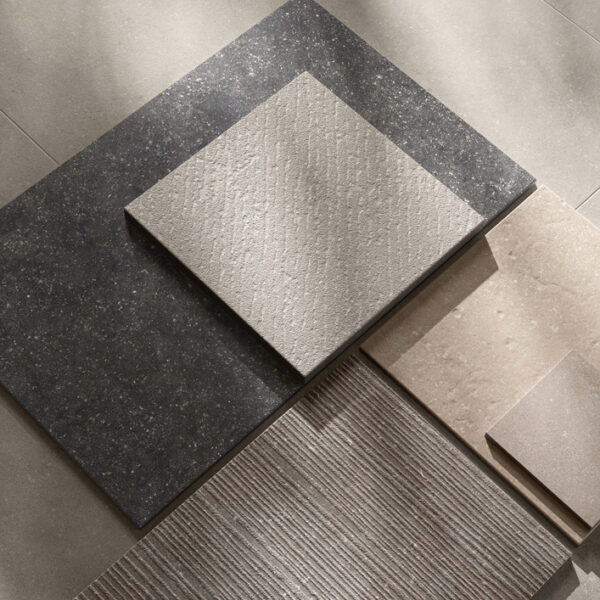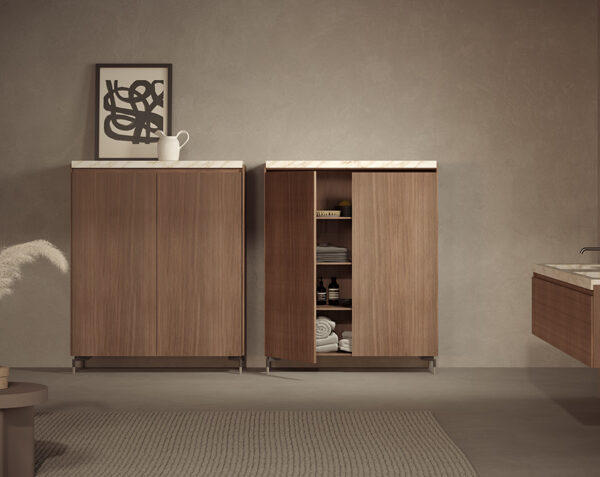Interviews

Ideas for objects that tell a story | by Alessandra Coppa
Article published in: "Ceramic, a trend-setting product"
Giulio Iacchetti sees research into everyday objects as an opportunity to reinvent them or create new types of products. When embarking on the design of an object, he first asks himself some questions and then concentrates on the “idea” in order to create concrete and functional forms that are nonetheless imbued with symbolic values.
Iacchetti’s experimentation goes beyond forms and materials and concentrates on the “meaning of objects” rather than their mere function. A clue to this approach can often be found in the name of the objects or in their relationship to a given context.
Giulio Iacchetti has been commissioned to design the bathroom furnishing halls at this year’s CERSAIE.
How did you begin your career as a designer?
My initial approach to design was rather naive. I was self-taught and started out by creating small models and prototypes based on my ideas, which I offered to companies on an extemporaneous basis. Over time I perfected my approach to potential new clients, but in practice I still often proceed in the same way. Looking back at my experience, I see a certain affinity with masters of design such as Enzo Mari and Aldo Rossi. I have always tried to understand Mari’s objects and to appreciate how he arrived at certain design solutions when approaching a specific type of product. I gleaned his teachings through direct contact with his objects. I needed to have them physically present without the mediation of videos or photos, because they have a certain resonance in terms of knowledge and the solutions they offer to complexity. Mari’s severe, intensive approach that permits no distraction from form was balanced by the much softer approach taken by Aldo Rossi, in whom I particularly admire his capacity to design everyday objects not through a functionalist approach but by reference to the archetype and to the forms that are already present in our memories at a subconscious level. He teaches us to go beyond the relationship between form and function and to suggest the form of objects as a kind of new point of arrival. And although this approach sometimes appears forced, it nonetheless touches our emotions. His few objects are all highly iconic and on the whole have been a commercial success.
What was your first object that was put into production?
It was a handle, which I designed as the final project of a training course I was attending. I showed the curved wooden model to a company, which decided to put it into production. That was a highly formative experience and I realised then that this would be my lifelong profession.
It seems to me that your projects “give shape” to an idea, that your reasoning is always based on a methodological approach that embraces doubt. Your objects are based on the critical analysis you carry out each time you embark on a design project. You once said that you allow the “idea to emerge”. What do you mean by that?
A project is a path, the outcome of a process. As designers we often deal with product types that have been explored in great depth and interpreted in many different ways. So in order to be able to say anything original, we have to first rediscover a meaning. We need to ask ourselves why something exists rather than throwing ourselves headlong into the creation of more or less abstract forms that provide a more or less “gestural” solution to a project. We need to set ourselves the primary goal of understanding the “why” of our actions, the “meaning” rather than the “method”.
There’s always a new way to do something but first we have to discover it. So to make an authentic contribution to the design of existing objects we need to proceed by trial and error, to allow “the idea to emerge”. In other words, “the project already exists” but you have to get there, and this is a work of exploration, of investigation. Over time everything of value “emerges” and returns to the surface. Noise, dirt, uselessness, complexity and redundancy all disappear, and in the best case only the idea remains. But to arrive at the idea you need to stir the waters, ask questions, try different approaches and make mistakes.
So the idea leads to the intention to give objects a “narrative”?
We sometimes think the theory that objects contain a narrative is a new invention, but in fact objects have always told stories, from the Rosetta stone to the watering can. Behind every object we can discern the thinking of its designer.
When I see a well-designed object that is perhaps as much as 1,000 years old, it moves me as if it were a beautiful poem or a work of art. An object is always capable of establishing a dialogue with the user.
I believe that narration is intrinsic to all objects. All objects have a tale to tell, whether it is complex, simple, banal or sublime.
The real question is not whether objects have something to say but whether we are prepared to listen. An object tells a story that obviously can be understood on various levels depending on the user’s capacity for understanding. Take for example Rossi’s coffee maker, fashioned in the shape of the cupola of San Gaudenzio in Novara. It has a clear story to tell, that of the scaling down of Antonelli’s cupola to the form of a coffee maker. But this small coffee machine, extrapolated from an urban landscape and placed in our small domestic setting, influences the relationship with the other objects in a kitchen. This in turn tells further stories, stories of harmony and equilibrium, of proximity and distance.
Could you tell us a story about one of your objects that you feel is emblematic so that we can understand what you mean by design?
I always end up talking about the Lingotto ice tray I designed for Guzzini, because it is an object that contains many small stories I am fond of. I was asked to design an object linked to water that would promote an awareness of its value as an essential and universal resource. So I thought of designing an ice tray which instead of creating classic ice cubes would produce small ingots with the word GOLD written on them.
So from a simple silicone rubber ice tray, Lingotto became a tool for thinking?
With Lingotto I make people think about the value of water but without being moralistic about it. Lingotto doesn’t force you to use less water, it simply produces blocks of ice in the form of ingots rather than classic cubes. Each ingot displays the word GOLD in relief on its smaller surface, promoting an awareness that water is a precious resource that should not be wasted.
Although it was originally design as a prototype for an exhibition, it subsequently became a consumer product manufactured by a large company. This concluded the experience, which is also a political statement as I believe that objects also have this function.
In the sense that in your designs you always refer to the “democratic” value of objects?
First we need to understand what is meant by “democratic objects”. I mean objects that can be understood by anyone, rather than hermetic, self-referential objects that make people wonder what they are or whose form requires an intellectual approach to be interpreted. For me an object must be direct, it must be accessible to everyone – a form of widespread participation that is part and parcel of democracy. Obviously it would be ideal if the price tag reflected this intention, but that’s not always possible. Unfortunately design is often associated with the words luxury and exclusivity. However, we need to make people understand that an object is expensive because it is well made and will last a long time.
Have you worked for companies in the ceramic and bathroom furnishing sectors?
In the past I have worked with sanitaryware manufacturer Globo and with IB Rubinetterie, a producer of taps, and I recently designed a tile collection for Refin. With Refin we designed a geometric decoration that would allow for extremely varied combinations of visually striking graphic elements. We worked passionately on this project, which is called Labyrinth because it creates a very engaging and variable pattern.
For Cersaie I have been commissioned to refurbish the Bathroom sector halls. Over the last year I have developed a design that will upgrade them and improve the experience for visitors. This includes redesigning the perimeter walls with a small but visually striking intervention, a kind of shiny flexible covering reminiscent of the flow of water. We also designed a special texture for the carpet which will cover the walkways and make the horizontal surface more elegant and exclusive.
BIOGRAPHY
Giulio Iacchetti has been working as an industrial designer since 1992, creating products for a wide range of brands including Abet Laminati, Alessi, Artemide, Ceramiche Refin, Danese, Fontana Arte, Foscarini, Globo, Magis, Moleskine and Pandora design. A major focus of his work is research and development of new types of objects, one example of which is the Moscardino reusable biodegradable spork designed in partnership with Matteo Ragni for Pandora design and winner of the 2001 Compasso d’Oro Award. In 2009 he won the “Premio dei Premi” award for innovation from the President of the Italian Republic for the Eureka Coop project, with which he introduced design into the large-scale retail sector. In May 2009 the Milan Triennale hosted a personal exhibition entitled “Giulio Iacchetti. Disobedient objects”. Ever attentive to the evolving relationship between craftsmanship and design, in November 2012 he launched an initiative entitled Internoitaliano, a “fabbrica diffusa” or “scattered factory” consisting of a network of artisanal workshops with which he designs furnishings and accessories inspired by Italian expertise and lifestyle.
At the same time he has pursued his own personal research projects in new areas of design. One example is his explorations of the Christian symbol of the cross that culminated in an exhibition entitled Cruciale held in the Diocesan Museum in Milan, in the Basilica di Santo Stefano Rotondo in Rome and at the Castello di Lombardia in Enna. With the exhibition “Razione K, il pasto del soldato in azione” (“Ration K, the meal of the soldier in action”), produced by the Milan Triennale in January 2015, he reflected on the essentiality and anonymity of food-related design.
In 2014 he won his second Compasso d’Oro award for the Sfera series of manhole covers designed together with Matteo Ragni for Montini.
Other articles published in Ceramic, a trend-setting product

From sight to touch: tactile surfaces and neutral colours
Progettare ambienti distensivi è un trend nell’interior design e i rivestimenti sono uno strumento fondamentale per raggiungere l’obiettivo, attraverso l’uso di tonalità neutre e finiture tattili

An eclectic bathroom
The latest interior design trends are seeing an increasingly close connection between the various rooms in the home, and the bathroom too is becoming a place of experimentation and openness





